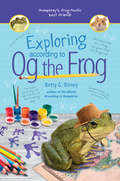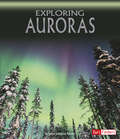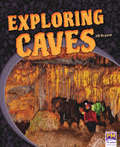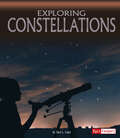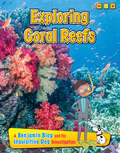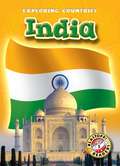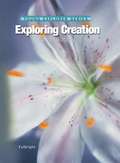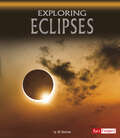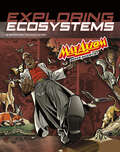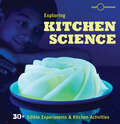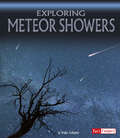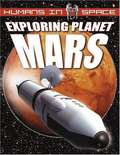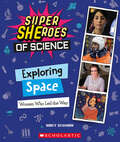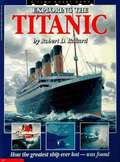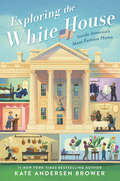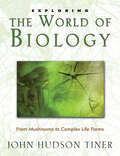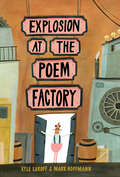- Table View
- List View
Exploring According to Og the Frog (Og the Frog #2)
by Betty G. BirneyIn the second book in the Og the Frog spinoff of the Humphrey series, Og is ready for adventure and is jumping at the chance to help kids be brave!Og loves the kids in Room 26, but he's awfully curious about the human world outside his tank! His friend Humphrey has no problem getting out and about, but it's harder for Og because he can't climb the way a hamster can. But Og never let hard work or fear stop him from going after what he wants. And he's determined to help the tads in Room 26 understand that taking risks can pay off--especially when they are being true to themselves. Whether it's learning that a younger kid can have great ideas, a student who learns differently can have hidden talents, or ideas that seem crazy at first can actually be amazing if you look at them from a different perspective, Og wants everyone to celebrate their talents. And once he fully embraces his frogginess--BING-BANG-BOING--he figures out how to go where no frog has gone before. Og's frog's-eye view of the world is curious, adventurous, and creative, and the perfect companion to Trouble According to Humphrey.
Exploring Auroras (Discover The Night Sky Ser.)
by Karen Latchana KenneyExplore the amazing science behind auroras.
Exploring Caves (Into Reading, Level T #33)
by Jill BryantNIMAC-sourced textbook <p><p> Caves are dark, mysterious places. They are found all around the world, and they can be exciting places to explore. Find out about the deepest cave ever explored, the oldest paintings found on cave walls, and a cave that was used as a school!
Exploring Constellations (Discover The Night Sky Ser.)
by Sara L. LattaExplore the amazing science behind constellations.
Exploring Coral Reefs: A Benjamin Blog And His Inquisitive Dog Investigation (Exploring Habitats With Benjamin Blog And His Inquisitive Dog Ser.)
by Anita GaneriJoin intrepid explorers Benjamin Blog and his inquisitive dog Barko Polo as they travel the globe exploring the world’s most exciting habitats! This book looks at coral reefs around the world, taking in a multitude of algae, polyps, fish, and other marine life along the way.
Exploring Countries India
by Jim BartellDeveloped by literacy experts for students in grades three through seven, this book introduces young readers to the geography and culture of India.
Exploring Creation with Botany
by Jay L. Wile Jeannie FulbrightThe book is written directly to the student, making it appealing to kids. Presenting science concepts in a conversational, engaging style makes science enchanting and memorable for your students. It also fosters a love for learning. This course is written for children between six and twelve years old. When the course is complete, this book will serve as an excellent reference for your family's future questions and studies in botany. As a result, this book is a life-long investment!
Exploring Early America (Unit 3: Early America)
by The Editors at the McGraw Hill- Wright GroupLearn more about the history of early America, as seen through the eyes of native peoples and European settlers and immigrants.
Exploring Eclipses (Discover The Night Sky Ser.)
by Jill ShermanExplore the amazing science behind eclipses.
Exploring Ecosystems with Max Axiom Super Scientist: 4d An Augmented Reading Science Experience (Graphic Science 4d Ser.)
by Agnieszka BiskupTrek along with Max as he explores the Earth's many ecosystems. Journeying to the desert, the tundra, even the depths of the sea, young readers will discover the world's many wonderful biomes. Download the free Capstone 4D app for an augmented reality experience that goes beyond the printed page. Videos, writing prompts, discussion questions, and hands-on activities make this updated edition come alive and keep your collection current.
Exploring God's World (Fourth Edition)
by Judy Hull MooreFourth graders will enjoy this fascinating presentation of things that they can see, observe, and understand in the world around them. Students will appreciate the miracle of plant germination, the causes of weather, the God-given provisions for life on earth, the design of the starry heavens, the ecology of the ocean depths, and many other aspects of God’s creative genius.
Exploring Kitchen Science: 30+ Edible Experiments & Kitchen Activities
by ExploratoriumDiscover the science that happens in kitchens every day with this fun collection of delicious experiments and amazing activities.The Exploratorium’s Exploring Kitchen Science is your hands-on guide to exploring all the tasty chemistry that goes on all around you—from burning a peanut to understand how calories work to making blinking rock candies with LEDs inside, from cooking up oobleck as a wild and wacky lesson in matter to making ice cream with dry ice! Watch Mentos and Diet Coke explode, Styrofoam shrink in a pressure cooker, and marshmallows duke it out. Make dyes from onionskins, tangy and yeasty sourdough bread, noodles of fruit, pickles a power source, and glow-in-the-dark Jello. Use cabbage juice as a pH indicator and salt and olive oil as a lava lamp. Whip up tasty treats while you explore all the unexpected science that’s going on inside your very own kitchen. Cook, mix and microwave your way through Exploring Kitchen Science and learn some cool stuff along the way.
Exploring Mars, the Red Planet (Rigby Literacy by Design)
by Darleen RamosChildren's book about the planet Mars
Exploring Meteor Showers (Discover The Night Sky Ser.)
by Brigid GallagherExplore the amazing science behind meteor showers.
Exploring Planet Mars (Humans In Space)
by David Jefferis Mat IrvineExploring Planet Mars looks at the scientific facts about Earth's nearest neighbor and delves into future exploration of the planet--possibly even colonization! Discoveries from the recent probes sent to the planet will be discurred and whether or not they help confirm signs of life on Mars.
Exploring Science
by Cengage Learning National Geographic LearningThis student edition covers 100% of Grade 4 Next Generation Science Standards.
Exploring Science: Grade 4
by Malcolm B. Butler Kathy Cabe Trundle Randy L. BellNIMAC-sourced textbook <p>Grade 4</p>
Exploring Space: Women Who Led the Way (Super SHEroes of Science) (Super SHEroes of Science)
by Nancy DickmannThis brand-new series highlights some of the major contributions women have made in the world of science. <p><p>From studying stars and discovering comets to flying into space as pioneering astronauts, women have been central to learning about space. Female astronomers gave us our first understanding of how large the universe really is and how much matter it contains. They were key to designing humans’ first rocket-powered flights into space. And as soon as women could go into space themselves, they were eager to do so: some 65 women have now become space travelers. This book tells their stories and describes their vital contributions. <P><P><i>Advisory: Bookshare has learned that this book offers only partial accessibility. We have kept it in the collection because it is useful for some of our members. Benetech is actively working on projects to improve accessibility issues such as these.</i>
Exploring the Solar System: A History with 22 Activities (For Kids Ser.)
by Mary Kay CarsonIn this stellar activity book, kids delve into the rich history of space exploration, where telescopes, satellites, probes, landers, and human missions lead to amazing discoveries. Updated to include the recent discovery of Eris which, along with Pluto, has been newly classified as a "dwarf planet" by the International Astronomical Union, this cosmic adventure challenges kids to explore the planets and other celestial bodies for themselves through activities such as building a model of a comet using soil, molasses, dry ice, and window cleaner; or creating their own reentry vehicle to safely return an egg to Earth's surface. With biographies of more than 20 space pioneers, specific mission details, a 20-page field guide to the solar system, and plenty of suggestions for further research, this is the ultimate guidebook to exploring the solar system.
Exploring the Titanic
by Robert D. Ballard Ken Marschall Patrick CreanTells the tragic and fascinating story of the unsinkable liner that disappeared without trace after hitting an iceberg on its maiden voyage. Laying unexplored for more than 70 years, the Titanic was discovered by Doctor Robert Ballard.
Exploring the White House: Inside America's Most Famous Home
by Kate Andersen Brower#1 New York Times bestselling author Kate Andersen Brower shares a special inside look into the most famous home in America—and the lives of hardworking staff members and first ladies who’ve maintained it. Have you ever wondered what exactly goes on inside 1600 Pennsylvania Avenue? Sure, the president of the United States works and resides there, but do you know who helps keep this historic house running?It’s no simple task, especially when there are important state events and foreign dignitaries—in addition to presidential pups, mischievous children, and even a couple of ghosts. And its Residence workers and first ladies make sure everything is in check and running smoothly. Featuring fascinating photos, fun facts, and memorable quotes from the residents and first ladies of the White House, Exploring the White House: Inside America's Most Famous Home is the perfect read for any curious kid!
Exploring the World of Biology
by John Hudson TinerDISCOVER THEWORLD OF LIFE AS GODCREATED IT! The field of biology focuses on living things, from the smallest microscopic protozoa to the largest mammal. In this book you will read and explore the life of plants, insects, spiders and other arachnids, life in water, reptiles, birds, and mammals, highlighting God's amazing creatio. You will learn about the following and so much more: How does biological classification give each different type of plant or animal a unique name? In what ways are seeds spread around the world? What food does the body use for long-term storage of energy? How did biologists learn how the stomach digested food? What plant gave George de Mestral the idea for Velcro? For most of history, biologists used the visible appearance of plants or animals to classify them. They grouped plants or animals with similar-looking features into families. Starting in the 1990s, biologists have extracted DNA and RNA from cells as a guide to how plants or animals should be grouped. Like visual structures, these reveal the underlying design or creation. The newest book in our Exploring series, Exploring the World of Biology is a fascinating look at life - from the smallest proteins and spores, to the complex life systems of humans and animals.
Explosion at the Poem Factory
by Kyle LukoffA funny story, full of wordplay, brings poetry alive as never before! Kilmer Watts makes his living teaching piano lessons, but when automatic pianos arrive in town, he realizes he’s out of a job. He spots a “Help Wanted” sign at the poem factory and decides to investigate — he’s always been curious about how poems are made. The foreman explains that machines and assembly lines are used for poetry these days. So Kilmer learns how to operate the “meter meter” and empty the “cliché bins.” He assembles a poem by picking out a rhyme scheme, sprinkling in some similes and adding alliteration. But one day the machines malfunction, and there is a dramatic explosion at the poem factory. How will poetry ever survive? Kyle Lukoff’s funny story, rich in wordplay, is complemented by Mark Hoffmann’s lively, quirky art. The backmatter includes definitions of poetic feet, types of poems (with illustrated examples) and a glossary of other terms. An author’s note explains the inspiration for the story. Key Text Features definitions glossary author's note Correlates to the Common Core State Standards in English Language Arts: CCSS.ELA-LITERACY.RL.2.4 Describe how words and phrases (e.g., regular beats, alliteration, rhymes, repeated lines) supply rhythm and meaning in a story, poem, or song.
